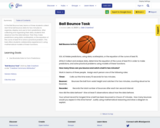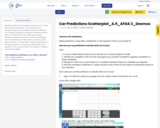
Comparing Linear and Exponential Models - Mathematics Instructional Plan
- Subject:
- Mathematics
- Material Type:
- Lesson Plan
- Provider:
- VDOE
- Author:
- VDOE
- Date Added:
- 10/07/2024

Comparing Linear and Exponential Models - Mathematics Instructional Plan

Modeling Data Using an Appropriate Function - Mathematics Instructional Plan

Exploring Exponential Models - Mathematics Instructional Plan

Determining Lines of Best Fit - Mathematics Instructional Plan

Exploration of Curve of Best Fit - Mathematics Instructional Plan

Introduction to Scatterplots and Regression - Mathematics Instructional Plan

Determining the Curve of Best Fit for Quadratic Functions and Models - Mathematics Instructional Plan

In the Ball Bounce task, teams of three students collect real-time ball bounce data for two minutes to organize, display and use to form predictions. After collecting and organizing their data, students first observe how the data behave. Then they make predictions using data, scatterplots, or the equation of the curve of best fit to solve a
practical problem. This task offers students collaborative experience in using mathematical models of linear functions.

Students research two variables about the car model they intend to purchase. They use Desmos to compare these same variables across five different car models. Students use analysis of bivariate data in order to decide which car makes sense to buy. Students prepare and share a summary statement and include desmos screen shots in order to justify their purchase. This task offers students experiences in making predictions, using data, scatterplots, or the equation of the curve of best fit for decision-making in a practical problem.

AFDA Catapults and Quadratic Regression Co-Teaching MIP

With your mouse, drag data points and their error bars, and watch the best-fit polynomial curve update instantly. You choose the type of fit: linear, quadratic, cubic, or quartic. The reduced chi-square statistic shows you when the fit is good. Or you can try to find the best fit by manually adjusting fit parameters.

Modeling Data Using an Appropriate FunctionMathematics Instructional Plans (MIPs) help teachers align instruction with the 2016 Mathematics Standards of Learning (SOL) by providing examples of how the knowledge, skills and processes found in the SOL and curriculum framework can be presented to students in the classroom.

In this task, students decide which team wins the egg-launching contest by analyzing data from a table, graph and a verbal representation with a quadratic equation. In doing so, students analyze data, determine the equation of the curve of best fit in order to make predictions, and solve practical problems using models of quadratic functions.

Exploring Exponential ModelsMathematics Instructional Plans (MIPs) help teachers align instruction with the 2016 Mathematics Standards of Learning (SOL) by providing examples of how the knowledge, skills and processes found in the SOL and curriculum framework can be presented to students in the classroom.

Determining lines of best fit Mathematics Instructional Plans (MIPs) help teachers align instruction with the Mathematics Standards of Learning (SOL) by providing examples of how the knowledge, skills and processes found in the SOL and curriculum framework can be presented to students in the classroom.

Curve of best fit explorationMathematics Instructional Plans (MIPs) help teachers align instruction with the Mathematics Standards of Learning (SOL) by providing examples of how the knowledge, skills and processes found in the SOL and curriculum framework can be presented to students in the classroom.

An introduction to scatterplots and regressionMathematics Instructional Plans (MIPs) help teachers align instruction with the Mathematics Standards of Learning (SOL) by providing examples of how the knowledge, skills and processes found in the SOL and curriculum framework can be presented to students in the classroom.

Determining the curve of best fit for quadratic functions and modelsMathematics Instructional Plans (MIPs) help teachers align instruction with the Mathematics Standards of Learning (SOL) by providing examples of how the knowledge, skills and processes found in the SOL and curriculum framework can be presented to students in the classroom.

In Zombie Attack, students will organize, display and analyze data to solve practical problems using models of exponential functions. Learners will use knowledge of transformations to write an equation, given the table and graph of an exponential function. In doing so, students will form connections between multiple representations of exponential functions for analysis, interpretation, and prediction.